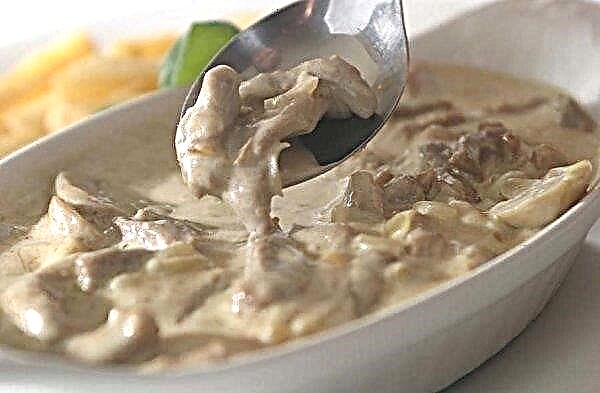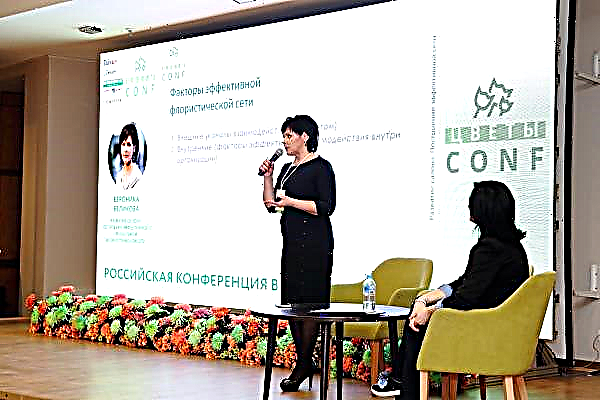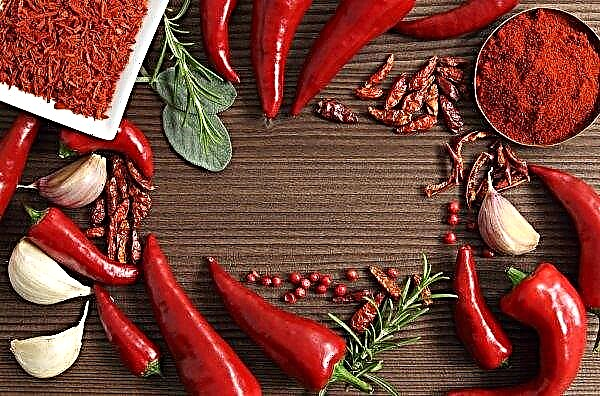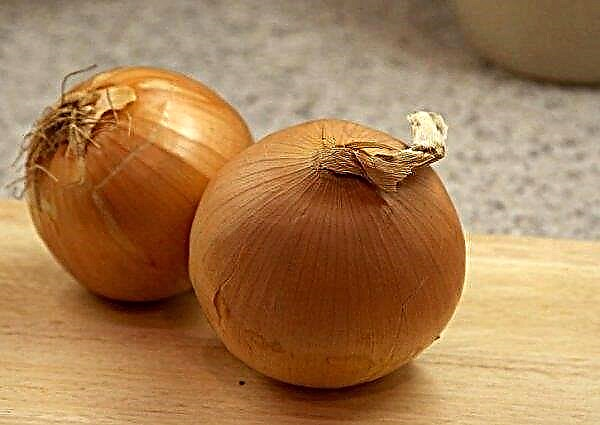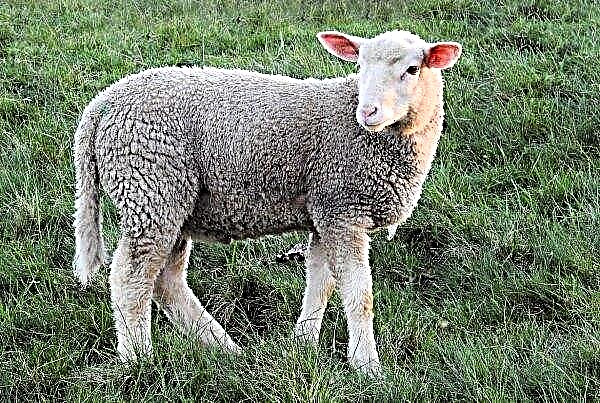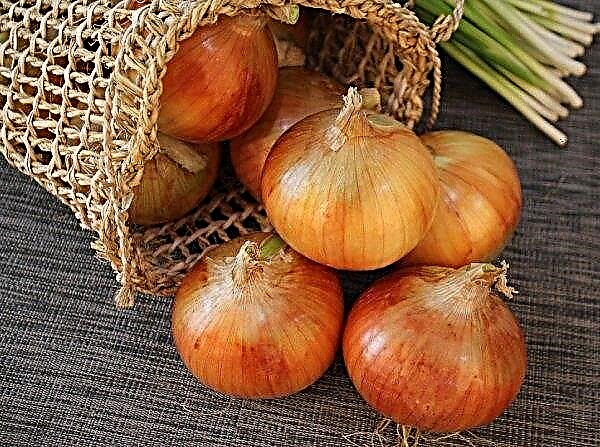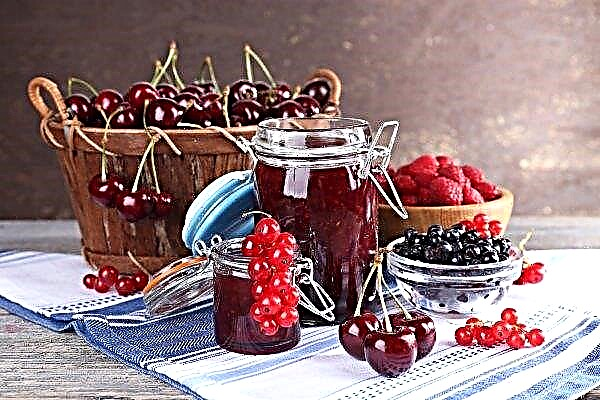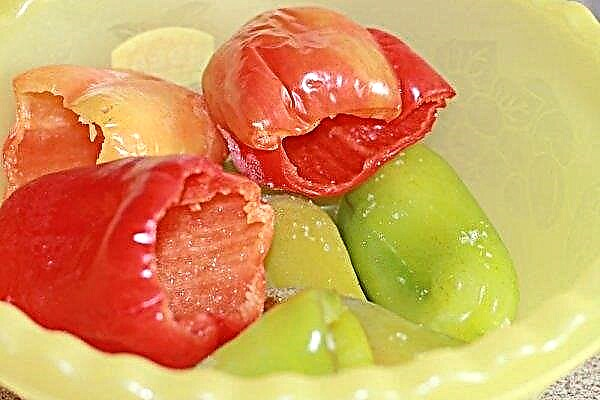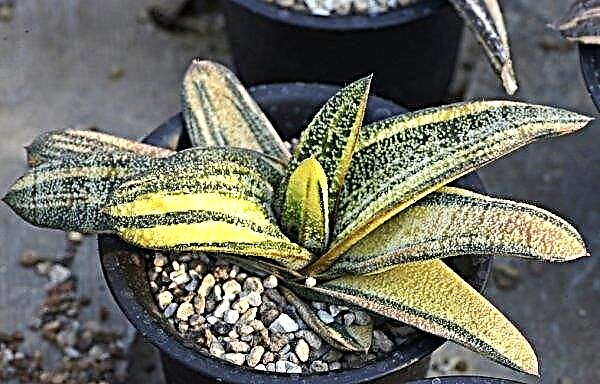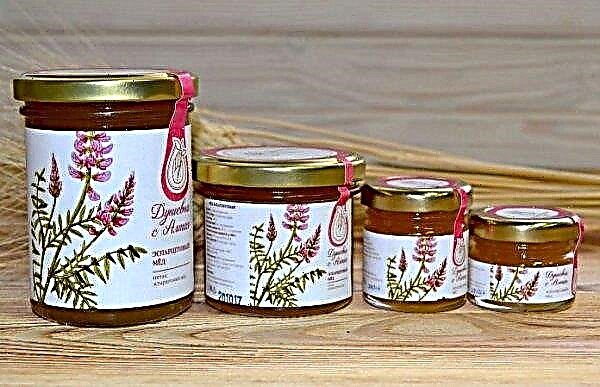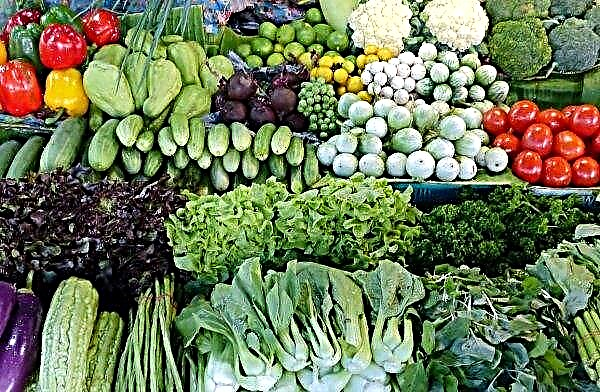Potatoes are grown everywhere in small plots of land and vast farmers' fields, and each variety of this crop has characteristics that are different from other varieties. In this article, we suggest that you familiarize yourself with Ryabinushka potatoes: a description and characteristics of the variety, cultivation agricultural technology, diseases, pests and ways to protect against them.
Selection history
Ryabinushka potatoes are the result of breeding work carried out by the Vsevolozhsk breeding station. The variety was officially included in the State Register of the Russian Federation in 2007 and recognized as suitable for cultivation in the Northwest, Northern and Central regions.
Description and characteristics of the variety
The Ryabinushka bush is not very sparse, almost upright, reaches a height of 40–50 cm, sometimes single tall bushes are formed, where the intermediate type of growth dominates. The bush is well leafy, the size of the leaf is medium to large, dark green in color. Flowers have a lilac-blue color of the petals.
Did you know? Potatoes can be poisonous, because they have solanine in tubers, the content of which increases many times after a long exposure of root crops under the sun. The first sign of poisonous potatoes is a dark green peel.
The variety is fruitful, early ripening, resistant to certain diseases and pests. Characteristics of Ryabinushka potatoes:
Characteristics of Ryabinushka potatoes:
- medium early table variety;
- the peel is smooth, burgundy;
- small eyes;
- oval-shaped potatoes with creamy pulp;
- the average weight of the fetus does not exceed 135 g;
- the starch content is 11.9-15%.
Did you know? Potatoes are an important source of vitamins and minerals. The average tuber eaten with a peel contains: 27 mg of vitamin C (45% of the recommended daily dose), 620 mg of potassium (18%), 2 mg of vitamin B5 (10%), thiamine, riboflavin, niacin, magnesium, phosphorus, iron and zinc.
Maturity and yield
The technical maturity of Ryabinushka comes in 2.5-3 months after the appearance of the first sprouts above the soil surface, the yield reaches 396 kg / ha.
Taste qualities
Root crops have a good taste, due to the high starch content, potatoes become friable, tasty and very satisfying after cooking.
Pros and cons of growing
- Positive aspects of the variety:
- excellent keeping quality (86–96%);
- high productivity;
- good taste;
- flat oval tubers;
- relative resistance to potato cancer, late blight and golden nematode.
- Negative sides:
- no very large tubers;
- the entire crop is medium sized.

Planting and growing potatoes
A good potato crop will be obtained by vegetable growers only if all the requirements of agricultural technology are observed: the correct planting dates, preparation of planting material, compliance with the intervals between rows and bushes when planting, crop rotation, taking into account the culture of the predecessor and soil composition.
Optimal landing times
A favorable temperature for planting potatoes in the southern regions occurs after April 10–15, and in areas with colder climates after May 1–9. At air temperatures below + 7 ° C, potato sprouts do not develop, and the mother tuber freezes in cold soil.
Too early planting can lead to rotting of tubers or freezing of young plants due to return spring frosts. To obtain a second crop, potatoes are planted from June 20 to July 20.
Crop rotation rules
Suitable for potatoes are all crops that leave the soil free of weeds, with the exception of vegetables belonging to the solanaceous family - tomatoes, peppers. Potato grows well after winter cereals. Also good predecessors are cabbage, onions, peas, beans, various root crops.
Potatoes can be grown for 2-3 years in one place if it is intended only for food, and the variety is not susceptible to nematodes. Potatoes are a good precursor to many crops.
Soil requirements
Cold, loamy soil with high acidity - unsuitable for growing potatoes. Heavy soils inhibit bush growth and tuber formation. On compacted soils with a low oxygen content, tubers remain small or choke and rot.
The best option for planting potatoes is chernozem and sandy clay soils. Good for this culture are neutral, slightly acidic (pH 5.8-6.8) soils, loose, fairly aerated, with a deep occurrence of soil water.
Did you know? Raw potato juice neutralizes stomach acid, so people with ulcers and gastritis can use it as a medicine.
Preparing planting material
After removal from the storage, the planting tubers must be sorted out and separated rotten and spoiled, after which they are heated and germinated. After germination, the growing season is reduced by 10-15 days, and productivity increases by 20-25%. Germination Technology:
Germination Technology:
- Germination works begin 35–40 days before planting. Root crops are placed in boxes or perforated polyethylene bags, where all tubers will be evenly lit.
- Use well-lit rooms or small greenhouses. During the first 10-12 days, the temperature in the room where the planting material germinates is +8 ... + 10 ° C, humidity is 85–90%, and lighting is poor. Under these conditions, more eyes wake up on the tuber, and accordingly, more sprouts grow.
- When the sprouts reach 1.5-2 cm, the temperature and humidity continue to remain in the same range, and the light intensity increases to 100%. For germination, fluorescent and conventional incandescent bulbs can be used.
- Germinated potatoes are lit no more than 10 hours a day. After 25-30 days, the sprouts reach 3-4 cm and are ready for manual planting. For the rapid development of bushes, tubers are treated with growth stimulants. Treatment with stimulants can be combined with preplant treatment of potatoes from diseases and pests.
Important! When machine planting sprouted potatoes, the length of the sprouts should not exceed 0.5-0.6 cm.
Landing technology
Planting material should be the same in shape and size of tubers, and also clean from viral diseases and pests.
Potato growers divide planting tubers into three fractions:
- up to 50 g;
- up to 80 g;
- more than 80 g
 Large tubers have more nutrients, which is of great importance for the initial development of the bush, but the consumption of planting material is very large. In private farms, large tubers are manually cut into several parts, most often in length, so that 3 or 5 eyes are present on each part.
Large tubers have more nutrients, which is of great importance for the initial development of the bush, but the consumption of planting material is very large. In private farms, large tubers are manually cut into several parts, most often in length, so that 3 or 5 eyes are present on each part.From these eyes, a potato bush will develop in the future. With a mass of 50-60 g, the tubers contain a sufficient amount of reserve substances and buds to provide the best bushes and high productivity.
Small tubers weighing 20–30 g are also suitable for planting if they are healthy and the growing conditions are favorable, but they should be placed 2-3 in a nest.
Potatoes are planted with an interval between rows of 60–75 cm, and observing the distance in the row between plants of 30–35 cm. The tubers are laid in grooves specially cut in the ground. On one hectare, an average of up to 5000 bushes is grown.
Important! Biologists have discovered more than 30 viruses that affect potatoes. In order to obtain planting material absolutely free from viruses, it is grown in laboratory conditions from seeds or by the method of cultivating tissues from sprouts or the upper part of young plants.
The potato planting depth is determined by the size of the tubers, soil condition and temperature. On heavy and moist soils, potatoes are planted to a depth of 6–8 cm, on light and loose soil to a depth of 10–12 cm. Planting material spread over furrows is covered with a soil layer of 10 cm.
Potato care after planting
Timely and proper care of potatoes Ryabinushka will help to get a good harvest.
The main activities for the care of potatoes:
- Soil care. A week after planting potatoes, the first harrowing of the soil is carried out, which will significantly reduce the appearance of weeds in the future. Before the first sprouts of potatoes appear on the soil surface, one or two harrows can be carried out. In small household plots, harrowing is carried out using garden rakes. After the bulk of the potato bushes is indicated, the first weeding is carried out. The purpose of weeding is to saturate the root layer of plants with oxygen and clean it of weeds. The depth of loosening of the soil in the rows between 5-7 cm, in the root layer is not deeper than 3-4 cm, which will prevent damage to the root system and stolons. The second weeding is carried out before the plants close in the aisles. Usually, the second weeding is combined with high hilling of bushes.
- Irrigation. If potatoes are planted on time and the soil during planting is sufficiently saturated with moisture, then the need for the first watering occurs when young bushes begin to develop. In the southern regions, potatoes are watered by sprinkling or drip irrigation; in any case, each irrigation should be plentiful enough so that the soil is wet to a depth of 30–40 cm. Three irrigations are carried out for the entire growing season: at the beginning of the growing season, before flowering, and end of flowering. In areas where there is a sufficient amount of precipitation, and the air temperature is kept within +25 ... + 28 ° C, they often do without artificial irrigation of potato fields.
- Fertilizer. After the emergence of sprouts on the surface of the soil, it is recommended to feed the potatoes with water-soluble nitrogen-containing and potassium fertilizers. There are two ways to carry out this procedure: fertilizers are dissolved in water and the plants are watered at the root, or granular dry fertilizer is scattered near the root system of potatoes before rain. Before flowering, you can feed the bushes with any nitrogen fertilizer, as well as urea, in the future only foliar fertilizing is carried out, according to the sheet.
- Pest and disease protection. As a preventative measure, potato bushes are sprayed on the leaf with fungicides from late blight and other fungal diseases, according to the instructions attached to the preparations. Also, plants need protection from pests (Colorado potato beetle, aphids), which can be ensured in large areas only by chemical treatment. In small household plots, biological preparations (garlic infusion, nettle infusion, and others) can be used for these purposes.

Grade Diseases and Pests
Without the protection of the potato field from diseases and insects harmful to plantings, you cannot get a good crop.
Common diseases:
- Blight or Phytophthora infestans - the cause of the disease is the germination of fungal spores, as a result of which spotty light green circles appear on the leaves of the potato, later changing color to black. Pale gray spores of the fungus are located on the underside of the leaves, gradually expanding, the mycelium infects and plant stems. Sick tubers can be distinguished from healthy potatoes visually, by gray spots located on the peel. In a section you can see that diseased root crops have brown flesh. The disease spreads en masse if the street is damp, and the air temperature has values from +11 ... + 22 ° C. In a latent state, fungal spores are found in diseased tubers, last year's tops, and in the ground. Prevention: do not grow potatoes for 2 years in a row, avoid excessive planting density, process planting tubers and growing bushes with systemic fungicides.
- Alternaria or Alternaria solani - The combination of prolonged rain and heat serves as an impetus for the outbreak of the disease. The first signs of the disease can be seen on the lower potato leaves in early June. They look like brown circles clearly defined by concentric rings. In the context of diseased tubers, mummified brown tissue can be seen. A source of infection of alternariosis is a sick top of potatoes, with which tubers come into contact when harvesting. Mushrooms winter on planting potatoes in the cellar and on plant debris in the field. Prevention: burning tops, cultivating sustainable varieties, using hillside fields, using fungicides.
- Potato Cancer or Synchytrium endobioticum - The disease subject to quarantine is caused by fungal spores. It is provoked by perennial mono-planting potatoes, the pathogens are viable for a long time in the ground. After detection of the disease, the infected fields are quarantined, they can not grow potatoes for 5 years. On the diseased potato, outgrowths of arbitrary shape appear from the eye, the size of the outgrowths is different. Large neoplasms are easily pressed, and fall off directly on potato beds, thereby infecting the soil. In the initial stage, these growths are pale yellow in color, then become brown, after which they rot and crumble. Prevention: prolonged quarantine of infected fields, cultivation of varieties resistant to potato cancer, use of sterile (from the laboratory) planting material.
- Potato scab or Helminthosporium solani - on the potato peel are silver-brown spots and sclerotia in the form of black dots. The scab is easier to see on the washed tuber. The pathogen enters the soil simultaneously with the planting of infected potatoes. The beginning of the development of the disease in the field is a delay in harvesting root crops during prolonged rains, and the subsequent storage of such an overripe crop in a too warm and damp storage. In the cellar, the disease spreads rapidly. Prevention: sterile planting potatoes, timely harvesting on a dry and warm day. To stop the mushrooms in the development phase, the tubers must be dried quickly after harvesting and then stored in a cool room. Processing of planting material with fungicides ("Tuberous shield", "Bator" or "Prestige").




Common pests:
- Colorado beetle - if you do not take measures, then these gluttonous parasites can completely eat the bushes and damage the tubers. Colorado beetles are on the list of the most dangerous pests for the garden because of their exorbitant appetite and ability to multiply rapidly. They are resistant to influences, quickly adapt to various climatic conditions and annually used poisons. In search of food, these pests can travel considerable distances and successfully winter in the ground in severe frosts, due to which they can accumulate in large quantities in one locality. During the growing season of the potato, the female Colorado potato beetle lays yellow egg clutches on the inside of the leaf; slippery pink larvae hatch after a short period of time. Before planting, potatoes can be processed from the Colorado potato beetle with Tirana, Maxim preparations. Leaf treatments are carried out by insecticides (Actellik, Iskra, Maltion, Bitoxibacillin, Prestige, Akhtar) as soon as the first pests hatch.
- Medvedka - the pest gnaws voids in the tubers, which stops the growth of the bush and reduces the quality of the crop. In addition, the insect does not tolerate a shadow over its masonry, and therefore often eats up a bush from which the shadow falls. In fields with a lot of bear, the crop can be damaged by 80%. To preserve root crops, comprehensive measures must be taken. The insect does not like calendula, so this plant should be planted around the perimeter of the potato field.Also, experienced gardeners recommend scattering crushed eggshells covered with vegetable oil before plowing in potato beds, during contact with which, the pest's airways will be blocked by a layer of oil, which will cause its death. You can also prepare a poisonous bait from equal parts of pre-boiled millet, corn and barley, mixed with 25 g of the drug Metafos. Before winter, several dozen shallow holes are dug up in the area infected with the bear, which is filled with cattle manure. For the winter, the bear hurry to take refuge in the warmth, so they climb into the dung. When severe frosts come, the gardener scatters the contents of the hunting holes in the garden. Left without shelter, the bear freezes.
- Wireworm - the pest is yellow-brown wireworm larvae with a body length of up to 2.5 cm. Tubers, roots and stems of plants are damaged, after which infections and rot occur in them. Adult root crops, permeated with wireworm moves, become unsuitable for eating and as seed material. The pest thrives and multiplies if crop rotation is not observed. Against wireworm, potatoes are treated with insecticides (Bazudin, Prestige or Provotox). On small beds, the soil is easy to clear of pests, if you plant marigolds there. Already for the next garden season, the beds will be clean from insects, and again suitable for growing vegetables.
- Nematodes - feed on tubers and root tissues. These small worms are almost impossible to deduce, since the life span of a cyst deposited by a female is measured for decades. Their presence can be detected by yellowing of the lower foliage, twisting of the stems, a significant lag of the infected plant in development from its neighbors. Only during harvesting on the roots of the affected bushes can you see small berries, these are cysts. The main characteristics of the nematode are resistance to frost, drought and pesticides. Potato stem nematode begins from a root infection. To avoid this, it is important to monitor the quality of the seed, and in the fall to organize the collection of weeds, fallen leaves and deep plowing of the field. Also, the tops of diseased plants are burned and plentiful watering of the infected soil with boiling water (in small areas) is carried out. Even after the measures taken, it is undesirable to continue planting root crops in this area for 3 years, and all this time it is advisable to grow beans or beans there. It is also useful to fertilize the potato field with chicken droppings that nematodes cannot tolerate.




Harvesting and storage
When the leaves of the Ryabinushka bushes turn yellow, and the tubers easily come off from the stolons, this means that the potato has ripened. If the root crops are intended for long-term storage, they are left in the ground for another 2 weeks, until the skin becomes thicker.
Important! Colorado beetles are destroyed by the biological method - pollination of potato bushes with basalt powder, clogging the skin pores of insects. As a result, striped pests are massively killed.
The strong peel on the potato prevents diseases that occur during storage and keeps the root vegetable juicy. But, if the tubers remain in the soil for too long, this increases the likelihood that they will be poorly stored and begin to rot.
- Before harvesting, the potato leaf is mowed, this procedure gives two advantages:
- when harvesting tops does not interfere with the work;
- root crops in the earth begin to actively grow a thick skin.
Depending on the volume, potatoes are dug out manually using a shovel or potato fork. On a large field, potatoes are harvested by potato harvesters or walk-behind tractors that dig tubers and shake them off the ground by vibration.
It is important that during harvesting the root crops are not mechanically damaged, such damage can serve as a source of rot and the development of diseases during storage. Potatoes of the Ryabinushka variety, harvested without damaging the peel, show good shelf life during long-term storage (86–96%). It is important not only to grow potatoes and harvest them in time, but also to store them correctly in order to prevent possible losses:
It is important not only to grow potatoes and harvest them in time, but also to store them correctly in order to prevent possible losses:
- Food potatoes. Before laying for storage, it is well dried for several days and cleaned in a basement or cellar. The temperature in the storage should remain between +8 ... + 12 ° C, humidity 80%. Potatoes can be stored both in small drawers for vegetables (up to 10 kg) and in containers with a capacity of up to 400 kg. From time to time, the storehouse must be inspected and inspected for storage of potatoes in order to detect rotten root crops. They must be removed so that rot does not spread to other vegetables.
- Planting potatoes. It is necessary not only to dry, but also to withstand in the light for a time sufficient for the acquisition of green vegetables (increase in the content of solanine in tissues). It is advisable to store planting potatoes at a temperature of +6 ... + 8 ° C, in a dark and well-ventilated storage with humidity from 85% to 90%.
Did you know? In the world there are almost 4,000 different varieties of potatoes. They are grouped according to the skin color - red, white, yellow and purple.
In order to grow a decent harvest of Ryabinushka potatoes, the vegetable grower must take care of fertilizing, watering, weeding the potato field and protecting plants from insects and diseases.

